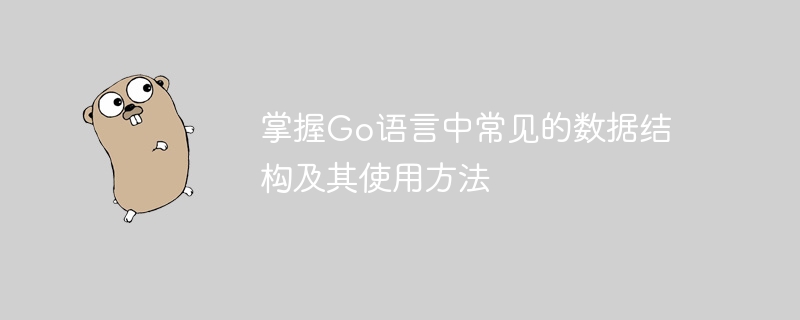学习在Go语言中使用常见的数据结构及其方法
- WBOYWBOYWBOYWBOYWBOYWBOYWBOYWBOYWBOYWBOYWBOYWBOYWB原创
- 2024-01-09 17:02:301021浏览

学习在Go语言中使用常见的数据结构及其方法,需要具体代码示例
在Go语言中,数据结构是一种组织和存储数据的方式。掌握常见的数据结构及其使用方法对于开发高效的程序至关重要。本文将介绍Go语言中常见的数据结构,并提供具体的代码示例。
- 数组(Array)
数组是一种存储固定大小元素的数据结构。在Go语言中,数组的长度不可变。
代码示例:
package main
import "fmt"
func main() {
// 创建一个长度为5的整数数组
var arr [5]int
// 给数组赋值
for i := 0; i < len(arr); i++ {
arr[i] = i * i
}
// 打印数组的值
for _, value := range arr {
fmt.Println(value)
}
}- 切片(Slice)
切片是Go语言中动态数组的实现。切片的长度可以动态改变。
代码示例:
package main
import "fmt"
func main() {
// 创建一个空切片
var slice []int
// 给切片添加元素
slice = append(slice, 1)
slice = append(slice, 2)
slice = append(slice, 3)
// 打印切片的容量和长度
fmt.Println("Capacity:", cap(slice))
fmt.Println("Length:", len(slice))
// 打印切片的值
for _, value := range slice {
fmt.Println(value)
}
}- 链表(Linked List)
链表是一种用于存储数据的线性数据结构。在Go语言中,可以使用指针来实现链表。
代码示例:
package main
import "fmt"
type Node struct {
data int
next *Node
}
type LinkedList struct {
head *Node
}
func (list *LinkedList) add(data int) {
newNode := &Node{data: data}
if list.head == nil {
list.head = newNode
} else {
current := list.head
for current.next != nil {
current = current.next
}
current.next = newNode
}
}
func main() {
linkedList := &LinkedList{}
linkedList.add(1)
linkedList.add(2)
linkedList.add(3)
current := linkedList.head
for current != nil {
fmt.Println(current.data)
current = current.next
}
}- 栈(Stack)
栈是一种后进先出(LIFO)的数据结构。在Go语言中,可以使用切片来实现栈。
代码示例:
package main
import "fmt"
type Stack struct {
data []int
}
func (stack *Stack) push(value int) {
stack.data = append(stack.data, value)
}
func (stack *Stack) pop() int {
if len(stack.data) == 0 {
return -1
}
value := stack.data[len(stack.data)-1]
stack.data = stack.data[:len(stack.data)-1]
return value
}
func main() {
stack := &Stack{}
stack.push(1)
stack.push(2)
stack.push(3)
value := stack.pop()
for value != -1 {
fmt.Println(value)
value = stack.pop()
}
}- 队列(Queue)
队列是一种先进先出(FIFO)的数据结构。在Go语言中,可以使用切片来实现队列。
代码示例:
package main
import "fmt"
type Queue struct {
data []int
}
func (queue *Queue) enqueue(value int) {
queue.data = append(queue.data, value)
}
func (queue *Queue) dequeue() int {
if len(queue.data) == 0 {
return -1
}
value := queue.data[0]
queue.data = queue.data[1:]
return value
}
func main() {
queue := &Queue{}
queue.enqueue(1)
queue.enqueue(2)
queue.enqueue(3)
value := queue.dequeue()
for value != -1 {
fmt.Println(value)
value = queue.dequeue()
}
}以上代码示例涵盖了Go语言中常见的数据结构及其使用方法。通过学习并掌握这些数据结构,可以提高程序的效率和可读性。希望本文对您学习Go语言的数据结构有所帮助。
以上是学习在Go语言中使用常见的数据结构及其方法的详细内容。更多信息请关注PHP中文网其他相关文章!
声明:
本文内容由网友自发贡献,版权归原作者所有,本站不承担相应法律责任。如您发现有涉嫌抄袭侵权的内容,请联系admin@php.cn

